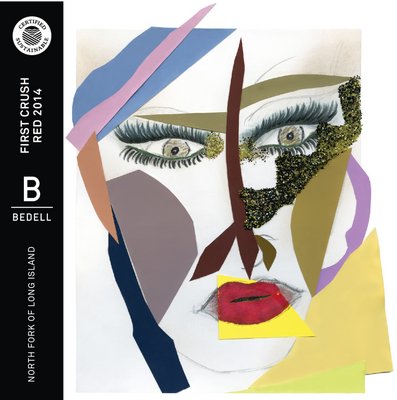
Every wine label, every bottle design, creates expectations. The package design makes the brand and, as such, is the best way to communicate the story behind the wine.
In the past, until the 1980s, wine packaging followed a format typical of a region. You could quickly tell by bottle shape and label elaboration whether a wine was from France, Germany, Italy, or Spain. But the rapid growth of the California wine industry opened the door to more unusual and innovative designs.
Initially, many American producers adapted European styles, thinking, “I’ve got cabernet, so my label should look like a Bordeaux wine.”
This kind of derivative thinking is now outmoded, and even European wine labels no longer follow a standard format. On Long Island, there are now more than 50 wine brands, some made by grower-producers, others by companies that buy fruit and have wine made at existing wineries.
Simple graphic designs, such Peconic’s Lenz Winery label, have the advantage of clarity. The Channing Daughters upside-down tree in Bridgehampton, or Wölffer Estate Vineyard’s horse head in Sagaponack, show the creative mind, or specific interest, of the owner. Labels from Bedell Cellars in Cutchogue feature artworks collected by owner Michael Lynne—adapting the artist label concept initiated by Château Mouton Rothschild, but with a contemporary look.
The most successful labels target a specific consumer. But sometimes, this kind of targeted branding backfires.
I experienced a culture clash recently in considering two cavas from Spain: Anna de Codorniu Brut Rosé and Paul Cheneau “Lady of Spain” Brut. The Anna Brut tasted refreshingly delicate, even elegant. Its label, however, is anything but. A film of pink plastic covers the entire bottle, featuring Anna, circa 1659, in a lace bonnet. Does this appeal to women? To me, the bottle looks like part of a campaign against breast cancer, or, worse, one of those plastic cases that used to come free with Tampax.
Okay, maybe the Spanish designer couldn’t have known what associations an American woman might have with his choices. The issue repeats itself—maybe only for me, I dunno—with Lady of Spain. The wine itself is delicious, appealing, but its shrink-wrapped package is sleazy.
It depicts a cartoonishly coquettish woman in a red dress on an orange—same color as the Veuve Clicquot label—background, supposedly a tribute to Barcelona’s art nouveau café society. The name alludes to the 1931 song “Lady of Spain,” once the theme of Lawrence Welk’s accordionist. Has no one told this producer how, in the 1977 film “Slap Shot,” the hockey coach portrayed by Paul Newman yells, “Don’t ever play ‘Lady of Spain’ again!” to the rink’s organist? And don’t they know the alternative lyrics, sung by 10-year-old children (when sex begins to be interesting), “Lady of Spain, I adore you; pull down your pants, I’ll explore you”?
Evidently, there is more to label design than creating pretty images. A few years ago, I visited a 1-million-gallon, multi-brand producer in northern Italy where different labels were applied to the same wine, depending on where it would be sold. The owner told me, “Americans want ‘pinot grigio,’ so we put it on their labels. No one else cares about the grape.”
The Alcohol and Tobacco Tax and Trade Bureau of the U.S. Treasury Department regulates wine labels here, and while it doesn’t mandate varietal designation, the TTB does require the packaging to include the brand name, wine type, origin, producer, bottler, alcohol content, net contents, declaration of sulfites and government health warning. This adds up to a mess of verbiage—and there can be even more if the producer adds vintage, variety, estate bottled, or vineyard designations.
Did you know that there is leeway on either side of the declared alcohol content? It need be accurate to only plus or minus 1.5 percent if the wine has an alcohol content of 14 percent; plus or minus 1.0 percent if the wine has an alcohol content of more than 14 percent. If it’s less than 14 percent, the producer may simply declare it to be “table wine” instead of listing the percentage of alcohol. Wines over 14 percent are in a separate category with a higher “sin” tax.
When a label says “Produced and bottled by …,” 75 percent of that wine was made by the producer. But “Cellared and bottled by …” needs only to have been treated some way, such as filtration, by the bottler. If the label says “bottled by …,” that’s all that bottler did before slapping his label on it.